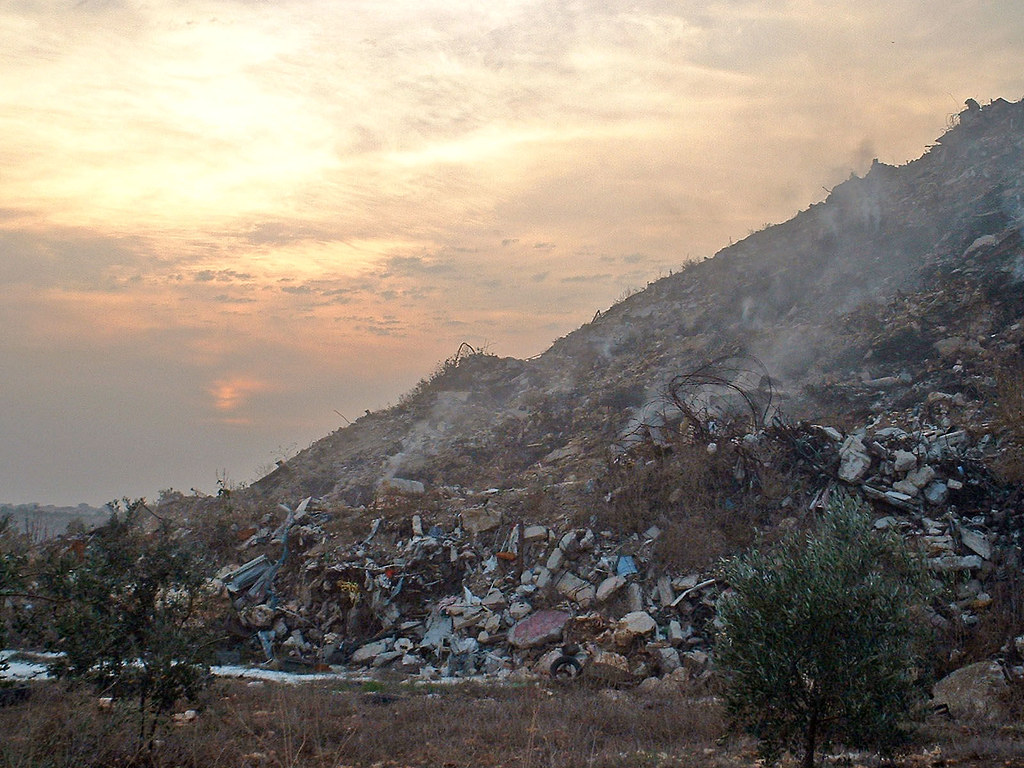When we moved to Grove City almost three years ago, we noticed yard signs expressing opposition to a “radioactive trash mountain” in the area. It was hard to find good information online about the proposed reopening of a local landfill, and from what I could tell, the permitting process was bogged down. (I wrote a brief op-ed for the Pittsburgh Post-Gazette on the way that the decline of local news contributes to an information vacuum in which projects like this can more easily move forward.) Recently, however, the landfill won approval from the state permitting agency, and while the original plans for a veritable “mountain” of refuse have been limited by local zoning requirements, the landfill seems likely to open in the coming years. Still, I wondered how bad it could be and whether it would in fact be radioactive.
When the local nonprofit that’s coordinating opposition to the landfill announced an informational meeting, I decided to go and see what I could learn. The overall tone of the meeting was quite grim: the legal options are running out, and while they’ve appealed to the state Commonwealth Court, the ongoing litigation has proved very costly. The folks opposing the landfill are quite committed, so there is still some hope that the appeal will be successful. The case now mostly hinges on whether the landfill violates FAA regulations as it is only a mile from the town airport and lies in the flight path of planes taking off and landing. Birds tend to cluster over landfills, and given the danger of bird strikes, there are regulations about the proximity of landfills to airports.
But the most serious concerns that residents have about the landfill relate to the waste it intends to take from fracking operations in the region. I’ve read some about fracking since moving to western PA, but as I did more research into how the waste gets handled, the picture only seemed more dire. Fracking generates massive quantities of flowback, which contains a proprietary blend of potent chemicals. Even during normal flow, the gas or oil comes out mixed together with “brine,” a liquid that contains salts, heavy metals, and various radioactive materials such as radium-226, radium-228, and radon. The mix varies from well to well and formation to formation, but the basic problem of how to deal with this toxic waste confronts all oil producers. Much of the liquid waste is pumped back down other wells, known as injection wells, but drill cuttings and other solids are often taken to local landfills.
After reading one particularly disturbing essay in Rolling Stone about this waste, I saw that the author, Justin Nobel, has a new book coming out this spring, and I requested an advance copy from the publisher. After reading Petroleum-238: Big Oil’s Dangerous Secret and the Grassroots Fight to Stop It, I’m still not sure how bad the problem of oil waste is or how concerned I should be about our local landfill, but I at least have a better understanding of why America is littered with radioactive sludge that infiltrates ground and drinking water.
Nobel traces America’s oilfield regulatory scheme to a set of laws enacted in 1980. Two key events shaped the debates over how to handle oil waste. The first was the growing awareness that American industry was fouling its own nest and something had to be done. Rachel Carson’s 1962 book Silent Spring gave voice to early concerns about pollution and spurred public outcry over the effects of industrial and agricultural chemicals. Legislators were still reluctant to pass regulations that would hamper the American economy, but high profile cases finally spurred action: While the oil slick on the Cuyahoga River regularly caught on fire, a photograph of a 1969 blaze went viral and symbolized the desperate need for action (actually, the photos that accompanied the 1969 story in TIME came from a 1952 fire on the river; but this just goes to show it was a regular occurrence). Accordingly, in 1970, the EPA was formed, and in the ensuing years it worked to rein in heedless pollution.
As regulations for industrial waste were being discussed in the late 1970s, though, the oil embargo and accompanying energy crisis made lawmakers hesitant to hinder oil production. It seemed like the US needed to increase domestic oil supply, not burden it with the costs of cleaning up its wastes. So the Solid Waste Disposal Act of 1980 included two key amendments. The Bevill Amendment exempted fossil fuel combustion waste and mining waste from special regulations, and the Bentsen Amendment exempted all waste stemming from the production of crude oil or natural gas. The EPA was supposed to assess these wastes and issue recommendations on how best to handle them at a later date. (Another bill in 1980 established the EPA’s Superfund program, and we already have one of those sites right in town.)
Nobel talks with Carla Greathouse, who was tasked with completing an EPA report in the 1980s. Her findings about the toxicity of oil wastes ended up being politically irrelevant as the EPA Administrator at the time passed on orders that “none of the oil and gas industry’s waste was to be labeled hazardous”:
The conclusions to her nearly 900-page report were, as Carla puts it, “politically altered.” These mandated conclusions read that defining oilfield waste as hazardous would be “unnecessary and impractical.” The industry simply produced too much waste, there weren’t enough appropriate disposal facilities to put it all, or regulators to regulate it. Labeling oilfield waste hazardous would also “pose a substantial financial burden on the oil and gas industry” and have a substantial impact on the U.S. economy,” disrupting the search for new oil and gas deposits in America.
This is why the trucks hauling oilfield brine aren’t marked hazardous, the waste is relatively unmonitored, and the radioactive drill cuttings, sludge, and other solids can be disposed of in local landfills.
Nobel’s book includes this legal history, and he also talks with many people who have been affected by the immense effort to deal with this waste. Truckers and other workers often don’t know the toxicity of the materials they’re dealing with, but many of them are desperate for work and are grateful for good paying jobs. Locals who have to deal with injection wells and other places where this waste is hauled and processed and stored have horrible anecdotes about smells, leaks, and sickness, but others are grateful for the economic opportunities this industry brings.
Nobel often lets his sources ramble on for pages, though, and it’s not clear which of their grievances are legitimate and which ones might be more spurious; there’s not much fact checking. To be fair, the companies involved rarely respond to his requests for information. Nobel gives examples of corruption and illegal dumping, but it’s hard to tell how widespread these violations are. Of course, even legal waste management practices cause plenty of harm.
Still, the risks posed by radiation in particular are notoriously difficult to quantify, and while he cites plenty of scary incidents, it’s not clear what the actual scope or shape of the problem might be. For instance, after spending pages describing the dangers of radon emissions from cooking with natural gas from the Marcellus formation, he acknowledges the research on these dangers is mixed and its harms are unclear: “Researchers at Carnegie Mellon University in Pittsburgh assessed the lung cancer risk from radon in Marcellus gas entering into homes across the Northeast and reported a detectable change in lung cancer death rates was ‘unlikely.’ But without more data on radon levels in natural gas distribution lines, the researchers stated, ‘it is difficult to dismiss public concerns.’” This doesn’t sound great, but it’s not at all clear which sources of radiation are of real concern and which ones—like cooking with gas—may pose negligible risks.
In a similar vein, Nobel describes the findings released last year from a large study conducted by the University of Pittsburgh and the Pennsylvania Department of Health that found no correlation between fracking well locations and cancer, though it did find links to higher rates of lymphoma and asthma. As you might expect, the oil industry has argued the findings about asthma are dubious, and many residents have expressed their own dissatisfaction with gaps in the methodology. This study didn’t look at the correlation between waste disposal and illness, and there is a real need for more research. Part of the problem here is that the people with the most money aren’t interested in funding studies to really understand the dangers of oil production, and this lack is filled in by people with dubious credentials who tend to focus on horror stories.
Nobel’s account of these arguments reminds me of Colin Jerolmack’s description of the fights over fracking in Up to Heaven and Down to Hell: locals who are trying to decide whether to lease their land to oil companies find themselves caught between slick salesmen and out-of-town “fractivists.” As Megan Fowler explains in her review of this book, Jerolmack found few people able to find common ground between those groups:
Bridging these distances more than anyone else was Ralph Kisberg, a Williamsport resident whom Jerolmack describes as holding a “(measured) anti-fracking stance.” Kisberg co-founded the Responsible Drilling Alliance because his years of working in offshore drilling taught him enough to worry that the drilling activity picking up around his hometown would endanger the landscapes of his childhood.
Kisberg knew all of the players in the drilling industry because he sought them out, built relationships with them, and worked to develop common ground among members of the Responsible Drilling Alliance and lessors who believed their decisions to lease were private matters. And Kisberg had some success in bringing the public’s attention to plans to drill around a beloved spot at a beautiful state park: due in part to his efforts, the gas companies put the plan on hold indefinitely.
Such commonsense compromises seem elusive when there is simply so much money to be made from drilling for oil and gas. What seems more likely is that corporations will hide the true risks and continue making as much money as they can, and affected populations will continue to be frustrated by their inability to get straight answers and may end up sickened by careless drilling and disposal. Many of the affected communities are rural and impoverished, and America has a long history of foisting the hazards of resource extraction on such places.
I’m aware, however, that this framing elides the rather obvious fact that these companies are responding to insatiable consumer demand for their products. As Casey Spinks points out, “there are no mustache-twirling billionaires drilling and digging and burning oil just for the hell and the money of it. Like money, petroleum is a very effective way to get the things we all want at the best convenience. And those in the oil industry are simply happy to oblige us and profit by their labors.” The blame for the radioactive and toxic waste coming to our town rests in part on the consumers who demand cheap fuel; it’s too easy to simply villainize the companies who supply it.
We heat our house and our water and our food with natural gas, and in many ways it’s a much cleaner source of energy than the readily available alternatives. It’s not like coal is a great option, and even on the rosy projections of industry boosters, it will be quite some time before we have reliable power generated by renewable energy. Even these technologies have their costs. Noah Toly is, unfortunately, right about the unavoidably tragic nature of our environmental choices. I’d willingly pay more for our natural gas if that meant responsible regulations would ensure the industry dealt with its waste responsibly, and there are some promising signs that Pennsylvania state lawmakers may place more restrictions on this waste. Still, it’s hard to imagine an effective regulatory regime reining in oil producers’ careless pollution when our country remains addicted to cheap energy.
This addiction may involve us in all sorts of ironies, but we need to untangle these and distinguish between irresponsible or absurd ironies and tragic or inescapable ones. In the irresponsible category, we might put technocrats flying in private jets to Davos to discuss global warming or nations simply labeling oilfield waste as “non-hazardous” to avoid properly dealing with it. There are other forms of ironic complicity that may be more unavoidable. When we lived in Michigan, I rode my bike to work along an old railroad grade that had been converted to a paved bike path thanks to funds the state earned through oil and gas leases. I now work at a college that has benefited for decades from money the Pew family earned through Sun Oil. The Au Sable Institute, which “inspires and educates people to serve, protect, and restore God’s earth,” derived significant funding from oil discovered on its campus.
The challenge, it seems to me, is to deal with our tragic complicity in the costs of energy production respectfully and responsibly rather than hide these costs or shunt the burdens to other people. In “The Gift of Good Land,” Wendell Berry concludes, “To live, we must daily break the body and shed the blood of Creation. When we do this knowingly, lovingly, skillfully, reverently, it is a sacrament. When we do it ignorantly, greedily, clumsily, destructively, it is a desecration. In such desecration we condemn ourselves to spiritual and moral loneliness, and others to want.”
I’m grateful for the tireless work of the citizens behind the local group trying to stop our landfill from opening up and accepting oilfield waste. In the absence of the state and federal regulation that is needed, they’re doing the best they can—and they’ve been doing it for decades. And despite the shortcomings of his book, I’m grateful for the efforts of Justin Nobel to uncover the real consequences of our national addiction to a messy fuel. Their work should remind us that rather than seeking the elusive mirage of purity, we ought to undertake the contested work of breaking the body of creation respectfully and responsibly. As Nobel demonstrates, the oil industry too often does this work ignorantly, greedily, clumsily, and destructively, and as the customers of this industry, we have an obligation to demand better.
Image via Flikr




